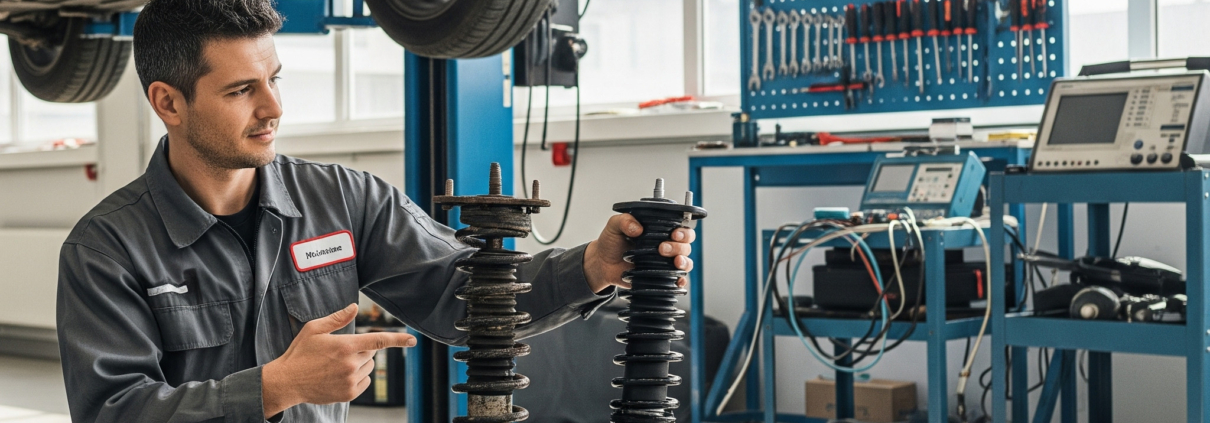Auto Shock Repair vs Replacement: Which Option Saves You More?
When your car’s suspension starts to feel bumpy, shaky, or unstable, one of the first suspects is often the shocks. Worn-out shocks not only make your ride uncomfortable but also reduce safety by affecting braking and handling. At this point, most drivers face a common question: should you go for auto shock repair or invest in a complete replacement?
This guide breaks down the differences between repair and replacement, the costs involved, and how to decide which option is best for your vehicle. By the end, you’ll know how to save money without compromising safety.
What Are Auto Shocks and Why Do They Matter?
Shocks, also known as shock absorbers, are part of your car’s suspension system. Their main job is to keep your tires firmly on the road, ensuring smooth handling and control.
Benefits of Healthy Shocks
- Improved safety: Better grip on the road reduces braking distance.
- Driving comfort: Absorbs bumps, potholes, and vibrations.
- Reduced wear: Protects tires and other suspension components from early damage.
- Fuel efficiency: Stable suspension helps your car perform more efficiently.
When shocks fail, your car may bounce excessively, nose-dive when braking, or sway on turns. Ignoring these signs can lead to costly repairs later.
Auto Shock Repair: When Is It Enough?
Sometimes, shocks don’t need a full replacement repairing them can restore performance and save money.
When Repair Works
- Minor leaks: If the seals are slightly worn but the shock body is still solid.
- Worn mounts or bushings: Replacing rubber parts may solve the issue.
- Low mileage wear: If shocks are relatively new and not completely damaged.
Pros of Repair
- Lower cost: Repairs are often cheaper than full replacements.
- Faster turnaround: Some fixes can be done in just a few hours.
- Good for newer cars: If shocks haven’t reached full lifespan, repairing makes sense.
Cons of Repair
- May not last as long as replacement.
- Not suitable for heavily worn or damaged shocks.
- If both shocks on the same axle are failing, repair isn’t always the safest choice.
Auto Shock Replacement: When It’s the Better Option
When Replacement Is Needed
- Severe oil leaks or physical damage to the shock body.
- Excessive bouncing after hitting bumps.
- Car nose-dives when braking or leans heavily on turns.
- Mileage over 50,000–70,000 miles, as most shocks wear out around this point.
Pros of Replacement
- Long-term reliability: Brand-new shocks restore factory performance.
- Improved safety: Essential for stable handling and braking.
- Better comfort: Restores smoothness for long drives.
- Warranty coverage: Many new shocks come with guarantees.
Cons of Replacement
- Higher upfront cost.
- Takes more time than small repairs.
Cost Comparison: Repair vs Replacement
Typical Costs
- Repair: $100–$250 per shock (depending on parts replaced).
- Replacement: $300–$800 for all four shocks (premium vehicles may cost more).
Which Saves You More?
- Short-term savings: Repair is cheaper if the issue is minor.
- Long-term savings: Replacement prevents repeated visits to the mechanic and protects other parts like tires and struts.
Think of it this way: if your shocks are still fairly new, a repair might buy you more time. But if they’re older or showing multiple signs of failure, replacement is the safer and more cost-effective option in the long run.
Tips for Deciding Between Shock Repair and Replacement
Check mileage: Over 60,000 miles? Replacement is usually best.
Inspect all four shocks: Don’t just fix one imbalanced shocks can cause uneven handling.
Consult a mechanic: A professional inspection will confirm whether shocks can be repaired safely.
Consider driving habits: If you drive on rough roads daily, replacement may be more reliable.
Common Mistakes Drivers Make
- Ignoring early signs: Waiting too long can cause more damage to tires and suspension.
- Replacing only one shock: Always replace shocks in pairs for balance and safety.
- Choosing the cheapest option: Low-quality shocks wear out quickly, costing more over time.
- DIY on critical parts: Unless you’re experienced, suspension repairs are best left to professionals.
2025 Trends in Auto Shock Repair and Replacement
The auto repair industry is evolving, and suspension care is no exception.
- Advanced materials: New shocks use lighter, stronger metals for durability.
- Smart suspension systems: Some vehicles now feature adaptive shocks that adjust to road conditions.
- Eco-friendly options: Rebuilt shocks are becoming popular for sustainability.
- Cost transparency: More repair shops are offering upfront pricing for shock services.
These trends mean drivers have more choices than ever before both for budget and performance needs.
Conclusion
So, auto shock repair vs replacement— which saves you more?
- If your shocks are still relatively new and the issue is minor, repair can be a budget-friendly fix.
- But if your shocks are leaking heavily, worn out, or past 60,000 miles, replacement is the smarter investment for safety, comfort, and long-term savings.
Keeping shocks in good condition isn’t just about a smooth ride it’s about protecting your vehicle and everyone inside it. When in doubt, get a professional inspection and choose the option that balances cost with safety.
For expert guidance and affordable auto shock repair or replacement, reach out to a trusted local service provider and keep your car performing at its best.


Leave a Reply
Want to join the discussion?Feel free to contribute!